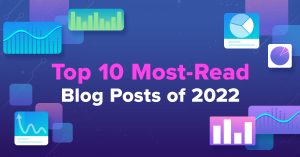More than 245 million customers visit their 10,900 stores and ten websites worldwide each week. In the fiscal year 2013, Walmart had sales of approximately $466 billion and employed 2.2 million associates. It is undeniably a name to be reckoned with in the retail sector.
 Data-driven decisions are more of the norm than the exception at Walmart. A large portion of their data efforts are based on social data—tweets, blogs, pins, comments, shares, and so on. The team at WalmartLabs.is in charge of mining all of that data to generate retail-related insights.
This is the first post in our Data Visualization Spotlight series, in which we show how various organizations use data visualization and analytics to solve day-to-day problems. You can replicate this tutorial using a Data Visualization Tool and see how the data converts to real-time social conversations into inventory.
Data-driven decisions are more of the norm than the exception at Walmart. A large portion of their data efforts are based on social data—tweets, blogs, pins, comments, shares, and so on. The team at WalmartLabs.is in charge of mining all of that data to generate retail-related insights.
This is the first post in our Data Visualization Spotlight series, in which we show how various organizations use data visualization and analytics to solve day-to-day problems. You can replicate this tutorial using a Data Visualization Tool and see how the data converts to real-time social conversations into inventory.
 Fig: By using real-time data visualization, the team observed a clear upswing in Walmart-related social buzz on 22nd November 2012, which gently reminded them of the promise that lay hidden deep within the treasure of the social data goldmine. Image Source: @WalmartLabs blog
In an age where information-sharing is easy, thanks to social media, such social buzz typically precedes all-important product launches. People are frequently expressing their views about the latest smartphone or the coolest video game hitting the shelf. WalmartLabs taps this social buzz and helps buyers plan their inventory and assortment.
Arun Prasath cites the following example. A few days ahead of its launch, Sony’s Android phone Xperia Z showed a similar spike in social activity.
Fig: By using real-time data visualization, the team observed a clear upswing in Walmart-related social buzz on 22nd November 2012, which gently reminded them of the promise that lay hidden deep within the treasure of the social data goldmine. Image Source: @WalmartLabs blog
In an age where information-sharing is easy, thanks to social media, such social buzz typically precedes all-important product launches. People are frequently expressing their views about the latest smartphone or the coolest video game hitting the shelf. WalmartLabs taps this social buzz and helps buyers plan their inventory and assortment.
Arun Prasath cites the following example. A few days ahead of its launch, Sony’s Android phone Xperia Z showed a similar spike in social activity.
 Fig: Such insights gathered through data visualization and social media analytics help its buyers make smarter decisions ahead of time. Image Source: @WalmartLabs blog
WalmartLabs uses such spikes in social network chatter to predict demand for out-of-the-ordinary products, too. In 2011, the team correctly anticipated heightened customer interest in cake-pop makers. They did so based on social media conversations on Facebook and Twitter. A few months later, it noticed a growing interest in electric juicers. This interest was linked to the popularity of the juice-crazy documentary Fat, Sick, and Nearly Dead. The team sends these data to Walmart’s buyers, who then use it to make their purchasing decisions.
Fig: Such insights gathered through data visualization and social media analytics help its buyers make smarter decisions ahead of time. Image Source: @WalmartLabs blog
WalmartLabs uses such spikes in social network chatter to predict demand for out-of-the-ordinary products, too. In 2011, the team correctly anticipated heightened customer interest in cake-pop makers. They did so based on social media conversations on Facebook and Twitter. A few months later, it noticed a growing interest in electric juicers. This interest was linked to the popularity of the juice-crazy documentary Fat, Sick, and Nearly Dead. The team sends these data to Walmart’s buyers, who then use it to make their purchasing decisions.
 Fig: The Social Media Analytics dashboard for buyers gives them better insight into consumers’ thoughts on products. Image Source: Gigaom.com
Walmart’s buyers also get a sense of what they should stock online and in stores by checking out pins on Pinterest. Top pins feed into a social-media analytics dashboard for buyers. So do the reports from Twitter that engineers have created by visualizing and analyzing Twitter feeds. Buyers can see when the number of tweets on, say, gel nail polish peaked and see the most popular colors in which locations.
Fig: The Social Media Analytics dashboard for buyers gives them better insight into consumers’ thoughts on products. Image Source: Gigaom.com
Walmart’s buyers also get a sense of what they should stock online and in stores by checking out pins on Pinterest. Top pins feed into a social-media analytics dashboard for buyers. So do the reports from Twitter that engineers have created by visualizing and analyzing Twitter feeds. Buyers can see when the number of tweets on, say, gel nail polish peaked and see the most popular colors in which locations.
 Data-driven decisions are more of the norm than the exception at Walmart. A large portion of their data efforts are based on social data—tweets, blogs, pins, comments, shares, and so on. The team at WalmartLabs.is in charge of mining all of that data to generate retail-related insights.
This is the first post in our Data Visualization Spotlight series, in which we show how various organizations use data visualization and analytics to solve day-to-day problems. You can replicate this tutorial using a Data Visualization Tool and see how the data converts to real-time social conversations into inventory.
Data-driven decisions are more of the norm than the exception at Walmart. A large portion of their data efforts are based on social data—tweets, blogs, pins, comments, shares, and so on. The team at WalmartLabs.is in charge of mining all of that data to generate retail-related insights.
This is the first post in our Data Visualization Spotlight series, in which we show how various organizations use data visualization and analytics to solve day-to-day problems. You can replicate this tutorial using a Data Visualization Tool and see how the data converts to real-time social conversations into inventory.
Table of Contents
Capturing the Social Retail Pulse Through Data Visualization
As Arun Prasath, Principal Engineer, WalmartLabs, points out in an article, “Social Media Analytics is all about mining retail-related insights from social channels, a perilous and personally exciting task to us. When our team spent the 22nd of November feverishly following the social retail pulse on Black Friday, we knew the world wasn’t preparing for an apocalypse.” Fig: By using real-time data visualization, the team observed a clear upswing in Walmart-related social buzz on 22nd November 2012, which gently reminded them of the promise that lay hidden deep within the treasure of the social data goldmine. Image Source: @WalmartLabs blog
In an age where information-sharing is easy, thanks to social media, such social buzz typically precedes all-important product launches. People are frequently expressing their views about the latest smartphone or the coolest video game hitting the shelf. WalmartLabs taps this social buzz and helps buyers plan their inventory and assortment.
Arun Prasath cites the following example. A few days ahead of its launch, Sony’s Android phone Xperia Z showed a similar spike in social activity.
Fig: By using real-time data visualization, the team observed a clear upswing in Walmart-related social buzz on 22nd November 2012, which gently reminded them of the promise that lay hidden deep within the treasure of the social data goldmine. Image Source: @WalmartLabs blog
In an age where information-sharing is easy, thanks to social media, such social buzz typically precedes all-important product launches. People are frequently expressing their views about the latest smartphone or the coolest video game hitting the shelf. WalmartLabs taps this social buzz and helps buyers plan their inventory and assortment.
Arun Prasath cites the following example. A few days ahead of its launch, Sony’s Android phone Xperia Z showed a similar spike in social activity.
 Fig: Such insights gathered through data visualization and social media analytics help its buyers make smarter decisions ahead of time. Image Source: @WalmartLabs blog
WalmartLabs uses such spikes in social network chatter to predict demand for out-of-the-ordinary products, too. In 2011, the team correctly anticipated heightened customer interest in cake-pop makers. They did so based on social media conversations on Facebook and Twitter. A few months later, it noticed a growing interest in electric juicers. This interest was linked to the popularity of the juice-crazy documentary Fat, Sick, and Nearly Dead. The team sends these data to Walmart’s buyers, who then use it to make their purchasing decisions.
Fig: Such insights gathered through data visualization and social media analytics help its buyers make smarter decisions ahead of time. Image Source: @WalmartLabs blog
WalmartLabs uses such spikes in social network chatter to predict demand for out-of-the-ordinary products, too. In 2011, the team correctly anticipated heightened customer interest in cake-pop makers. They did so based on social media conversations on Facebook and Twitter. A few months later, it noticed a growing interest in electric juicers. This interest was linked to the popularity of the juice-crazy documentary Fat, Sick, and Nearly Dead. The team sends these data to Walmart’s buyers, who then use it to make their purchasing decisions.
 Fig: The Social Media Analytics dashboard for buyers gives them better insight into consumers’ thoughts on products. Image Source: Gigaom.com
Walmart’s buyers also get a sense of what they should stock online and in stores by checking out pins on Pinterest. Top pins feed into a social-media analytics dashboard for buyers. So do the reports from Twitter that engineers have created by visualizing and analyzing Twitter feeds. Buyers can see when the number of tweets on, say, gel nail polish peaked and see the most popular colors in which locations.
Fig: The Social Media Analytics dashboard for buyers gives them better insight into consumers’ thoughts on products. Image Source: Gigaom.com
Walmart’s buyers also get a sense of what they should stock online and in stores by checking out pins on Pinterest. Top pins feed into a social-media analytics dashboard for buyers. So do the reports from Twitter that engineers have created by visualizing and analyzing Twitter feeds. Buyers can see when the number of tweets on, say, gel nail polish peaked and see the most popular colors in which locations.



Trudy Walter
March 27, 2014, 6:00 amIs there a specific social media listening tool that you used to monitor this data? Or was it through a combination of tools? If yes, what tools/software programs?
shilpi
March 27, 2014, 2:37 pmHi Trudy,
As I mention in my article, the “task of mining all that data to generate retail-related insights rests on the team at WalmartLabs.” Walmart uses Social Genome, a gigantic knowledge graph that helps Walmart reach its customers based on semantic analysis of real time social media streams. The Social Genome provides Walmart with a layer of social metadata containing customers, topics, products, locations and events.
Thanks
Bill Lyons
March 27, 2014, 9:25 pmI’m sorry, but this does not answer the question. I just Googled “social genome,” and can find no “tool” or “software program,” identified as “social genome.” It appears to be a “data-rich model” created by a project initiated by the Brookings Institution. But that begs the question of the tools used to create it.
shilpi
March 28, 2014, 5:03 pmTo know more about Walmart’s Social Genome and how it works, you can check out this link: http://vint.sogeti.com/fueling-sales-with-social-data-the-story-of-walmart-labs-the-social-genome/
Hope this helps.
citiesocial coupon
November 7, 2018, 9:02 amIt’s impressive that you are getting ideas from this paragraph as well as
from our discussion made at this time.